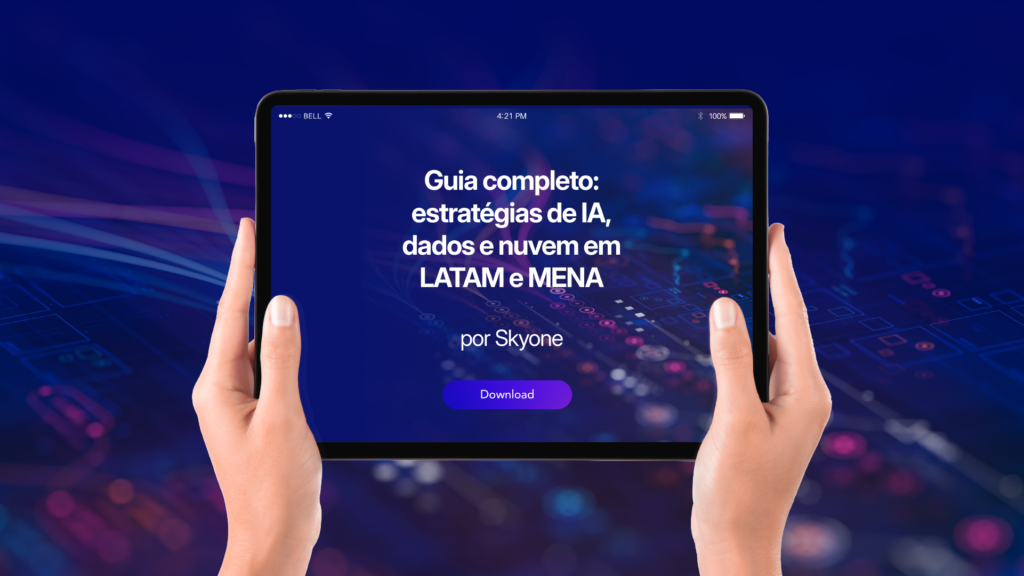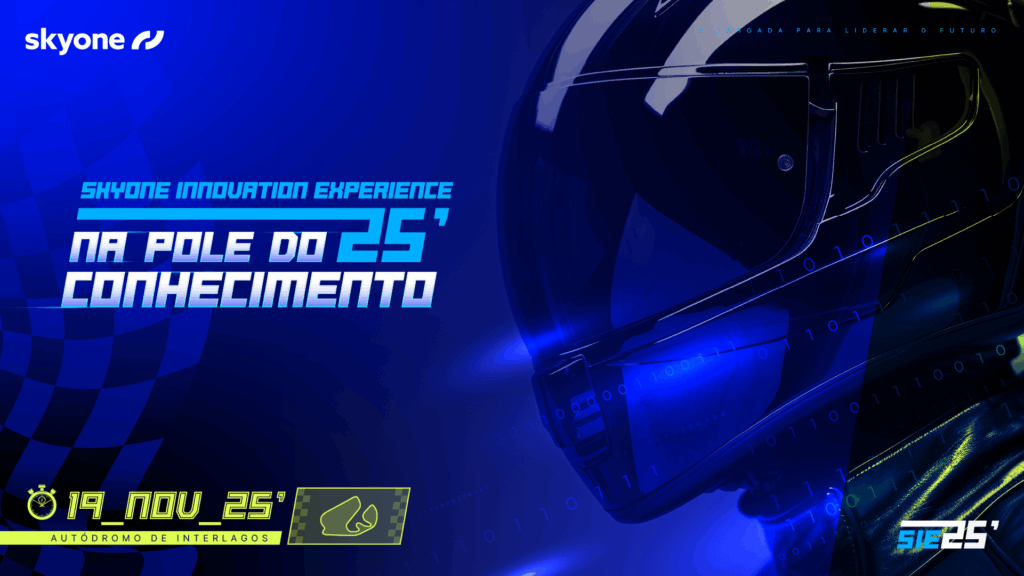Introdução
Não é de hoje que a inteligência artificial (IA) entrou no radar das empresas. Mas à medida que ela se torna parte do dia a dia, da automação de processos à análise de dados em tempo real, surge uma dúvida recorrente: como escolher o melhor modelo para colocar a IA em prática?
Essa decisão tem ganhado cada vez mais peso. Segundo a McKinsey, 78% das empresas no mundo já utilizam alguma forma de IA em seus processos internos. Mas, mesmo diante desse avanço, muitas organizações ainda se veem diante de um impasse: seguir por uma estrutura self-hosted, com mais controle e personalização, ou adotar soluções em cloud, com mais agilidade e escalabilidade?
O que está em questão aqui vai além da tecnologia. Envolve questões práticas, como quem cuida dos dados, quais os custos envolvidos, quão rápido é possível escalar, e principalmente, qual modelo se encaixa melhor na realidade e nos objetivos de cada empresa.
Neste artigo, vamos apresentar como funcionam os dois modelos, onde estão as principais diferenças e o que considerar antes de fazer sua escolha. Também vamos trazer um panorama das tendências mais recentes em IA, e mostrar como a Skyone pode apoiar sua empresa, com uma estrutura flexível, segura e preparada para evoluir com você.
Vamos nessa?
Modelos self-hosted e cloud: duas rotas para aplicar IA
Quando falamos em colocar a inteligência artificial para rodar de fato, é preciso entender que existem diferentes caminhos, e eles começam pela forma como a tecnologia será implementada e gerenciada. Entre as opções mais adotadas hoje estão os modelos self-hosted e cloud. Ambos têm potencial para entregar resultados robustos, mas operam com lógicas e responsabilidades bastante distintas.
A seguir, explicamos o que caracteriza cada um deles, como funcionam e em quais contextos costumam ser aplicados
Modelo self-hosted: IA sob seu controle
No modelo self-hosted, a empresa é responsável por hospedar, executar e manter toda a infraestrutura de IA. Isso significa que os modelos são executados em servidores próprios, seja localmente ou em ambientes dedicados na nuvem privada, com total controle sobre os dados, processos e ajustes técnicos.
Esse modelo é frequentemente escolhido por organizações que lidam com informações sensíveis, que possuem requisitos rigorosos de compliance ou que precisam de alto nível de personalização nos algoritmos. Ao assumir essa gestão, a empresa também centraliza decisões sobre segurança, performance e escalabilidade, o que exige equipe técnica qualificada e infraestrutura robusta.
Apesar da complexidade, o self-hosted oferece um grau de autonomia difícil de alcançar em soluções terceirizadas — o que o torna estratégico para quem valoriza controle absoluto e flexibilidade avançada.
Modelo cloud: IA como serviço
Já o modelo cloud opera com base em serviços fornecidos por grandes plataformas, como AWS, Microsoft Azure ou Google Cloud. Aqui, a empresa acessa a IA como um serviço, utilizando recursos de processamento, armazenamento e modelos prontos via internet, sem precisar montar e manter sua própria infraestrutura.
Essa abordagem é ideal para negócios que buscam rapidez na implementação, custo inicial mais baixo e escala sob demanda. Em vez de se preocupar com a operação técnica da IA, a equipe pode focar no uso da tecnologia para gerar valor, como automatizar processos, extrair insights de dados ou criar experiências mais inteligentes para clientes.
Além disso, o modelo cloud facilita atualizações constantes e acesso a recursos de ponta, com suporte direto dos provedores — o que pode ser um diferencial importante em ambientes de inovação acelerada.
Esses dois modelos representam abordagens distintas, cada um com suas vantagens, desafios e aplicações mais comuns. Mas quando colocamos os dois lado a lado, as diferenças ficam ainda mais evidentes.
Por isso, a seguir, vamos comparar os principais critérios que influenciam essa decisão. Isso vai ajudar você a entender não só o que muda na teoria, mas principalmente o que muda na prática.
Frente a frente: comparando ambos os modelos
Agora que entendemos como funcionam os modelos de IA self-hosted e cloud, vale olhar com mais atenção para o que realmente muda na prática entre eles. A escolha entre um ou outro tem impacto direto em áreas como estrutura de TI, gestão de dados, escalabilidade da operação, manutenção de sistemas e controle de custos.
É comparando esses pontos que muitas empresas percebem qual modelo atende melhor sua realidade ou mesmo se preferem considerar uma abordagem híbrida. A seguir, analisamos os principais critérios que influenciam essa decisão.
Infraestrutura e manutenção
No modelo self-hosted, a empresa assume toda a responsabilidade pela estrutura técnica e pela operação do ambiente. Isso inclui a compra e gestão de servidores, rede, armazenamento e processamento, além da manutenção de tudo isso: atualizações, segurança, monitoramento e suporte. Esse controle total permite personalizações profundas, mas exige investimentos significativos e uma equipe técnica dedicada.
Já na abordagem cloud, tanto a infraestrutura quanto a manutenção ficam sob responsabilidade do provedor. A empresa usuária acessa os recursos prontos para uso, com atualizações, correções e disponibilidade garantidas como parte do serviço contratado. O foco se desloca da gestão da tecnologia para o uso da IA em si, com menos complexidade e tempo de implementação muito menor
Dados
Em soluções self-hosted, os dados permanecem sob domínio total da empresa. Isso é especialmente relevante para organizações que lidam com informações sensíveis ou estão sujeitas a exigências de conformidade, como LGPD (Lei Geral de Proteção de Dados) ou normas do setor Financeiro.
No modelo cloud, os dados são processados em ambientes externos, controlados pelo provedor. Embora os grandes players ofereçam padrões robustos de segurança, essa abordagem exige confiança na política e estrutura do fornecedor, além de uma análise cuidadosa de contratos e termos de uso.
Escalabilidade
Com o modelo self-hosted, expandir a operação significa adquirir mais recursos internos (como servidores ou licenças), e realizar reconfigurações técnicas. Isso leva tempo e depende da capacidade da estrutura instalada.
Já no modelo cloud, escalar é rápido e flexível. Basta ajustar os serviços contratados para acessar mais processamento, armazenamento ou ferramentas, de forma quase imediata. Isso é útil em momentos de pico ou para negócios que crescem rápido.
Custos
O modelo self-hosted normalmente exige um investimento inicial alto, com aquisição de hardware, licenças e montagem da infraestrutura. Em contrapartida, os custos ao longo do tempo tendem a ser mais previsíveis, uma vez que a empresa controla a operação.
Em cloud, por outro lado, o modelo de pagamento é por uso. É possível começar com pouco e expandir conforme necessário, sem grandes investimentos iniciais. No entanto, esse modelo exige atenção para não perder o controle de gastos conforme o uso aumenta.
Como você pode notar, agora fica mais fácil visualizar as diferenças entre os dois modelos, especialmente quando colocamos todos os critérios lado a lado. Para facilitar e arrematar, na tabela comparativa a seguir, resumimos os principais aspectos que devem entrar no radar de quem está considerando essa decisão:
| Critério | Modelo de IA self-hosted | Modelo de IA cloud |
| Infraestrutura e manutenção | Gerida pela empresa.Exige investimento, equipe técnica e suporte contínuo. | Gerenciada pelo provedor.Ativação rápida e sem gestão interna. |
| Dados | Armazenados internamente.Maior controle e conformidade. | Processados externamente. Depende da política do provedor. |
| Escalabilidade | Expansão mais lenta, com necessidade de estrutura física. | Escalabilidade imediata conforme demanda. |
| Custos | Alto investimento inicial.Custos recorrentes mais previsíveis. | Baixo custo inicial.Custo variável conforme uso. |
A comparação deixa evidente que não existe um modelo universalmente melhor. Tudo depende do que cada empresa precisa priorizar. Em alguns casos, o controle e a personalização do self-hosted são chave; em outros, a agilidade e a elasticidade do cloud falam mais alto.
Entretanto, a decisão não se resume a infraestrutura ou orçamento. Para escolher com mais segurança, é preciso entender onde cada modelo realmente entrega valor, considerando o contexto do negócio, as demandas do setor e o grau de maturidade digital da organização.
E é isso que continuamos a explorar a seguir.
Na balança: quando cada modelo faz mais sentido?
Depois de comparar os modelos ponto a ponto, é hora de sair da teoria e entrar no dia a dia. Afinal, a escolha entre self-hosted e cloud vai além da ficha técnica. Ela passa por perguntas como: quais os riscos que minha empresa precisa evitar? Quão rápido precisamos evoluir? Já temos base para sustentar uma operação de IA internamente?
Esta é a virada de chave: entender quando cada modelo faz mais sentido, de acordo com o momento e os objetivos da organização.
Quando o modelo self-hosted se destaca
O modelo self-hosted costuma ser adotado quando o controle total da operação de IA é uma exigência, e não apenas uma vantagem. Em setores como Financeiro, Saúde e Governo, por exemplo, a proteção de dados e a conformidade regulatória impõem limites que tornam o cloud inviável em determinadas camadas do projeto.
Assim, ele aparece como escolha natural quando:
- O negócio envolve dados sensíveis e obrigações regulatórias rígidas, como em bancos, hospitais, seguradoras e órgãos públicos;
- Já existe uma estrutura técnica sólida, com times internos preparados para manter, ajustar e evoluir a operação com segurança;
- O projeto de IA tem valor estratégico e requer diferenciação, como modelos proprietários, integrações complexas ou algoritmos treinados com bases internas.
Como exemplo de caso de uso, podemos mencionar a J.Hilburn, marca americana de moda personalizada, que optou por uma infraestrutura dedicada e sob sua gestão para processar dados sensíveis de clientes com máxima segurança. Com essa abordagem, a empresa conseguiu reduzir em 50% o tempo de análise de pedidos, mantendo controle total sobre a operação.
Onde o modelo cloud mostra mais vantagem
Por outro lado, o modelo cloud brilha quando a prioridade está em agilidade, escalabilidade sob demanda e menor complexidade de gestão. Ele se encaixa bem em contextos como:
- Startups ou áreas de inovação em grandes empresas, que precisam experimentar, testar e lançar projetos com rapidez;
- Times enxutos ou estruturas em crescimento, que não têm recursos para operar e manter ambientes robustos por conta própria;
- Empresas que buscam acesso contínuo às últimas tecnologias de IA, com atualizações automáticas e suporte de grandes provedores.
Outro exemplo real: a Strise.ai, startup norueguesa de análise de compliance, migrou seus modelos para o Google Cloud e, com Dataproc e GKE, e conseguiu triplicar sua capacidade de processamento em menos de cinco minutos.
Esses dois cenários apenas reforçam o que afirmamos: a melhor escolha não está em rótulos, mas em coerência com a realidade de cada empresa. O que hoje parece um dilema pode, na verdade, ser um ponto de partida para pensar a IA de forma mais flexível, combinando o que cada modelo tem de melhor.
Na próxima seção, vamos olhar justamente para esse futuro híbrido que já começa a se consolidar, e entender como ele pode destravar novas possibilidades para os negócios. Continue conosco!
Tendências: IA em evolução e o que vem pela frente
Quando falamos em tendências, não estamos tratando de previsões distantes: estamos olhando para decisões que já estão no centro das estratégias digitais mais modernas. Empresas que antes viam a IA como um projeto isolado agora encaram a tecnologia como parte viva da operação, moldável, conectada e, acima de tudo, adaptável ao que o negócio precisa.
Neste cenário, surgem movimentos que estão redesenhando como a inteligência artificial é adotada, gerida e evoluída nas empresas. E o mais interessante: essas transformações não vêm de um único caminho, mas da combinação inteligente de diferentes abordagens. A seguir, destacamos as cinco tendências mais relevantes que estão pavimentando esse novo momento da IA.
- IA híbrida como estratégia corporativa: ambientes 100% cloud ou 100% on-premise estão ficando para trás. Empresas estão adotando arquiteturas híbridas que combinam a elasticidade da nuvem pública com o controle de ambientes privados, especialmente em setores regulados. Segundo a Foundry, 64% das médias empresas já priorizam essa integração mista para otimizar custo, segurança e performance;
- Open-source impulsiona inovação acessível: modelos como LLaMA e Mistral estão abrindo caminho para uma IA mais personalizável e economicamente viável. Com código aberto, empresas conseguem treinar modelos em dados próprios, adaptar algoritmos e evitar o “lock-in” (“travada”) de grandes players. Hoje, mais de 90% das empresas que usam IA já incorporam ferramentas open-source no seu stack, segundo a GitHub Octoverse;
- Small Language Models (SLMs) – IA prática e leve: em vez de depender de modelos gigantes e caros de operar, muitas empresas estão adotando SLMs, que são modelos menores, mais rápidos e focados em tarefas específicas. Essa abordagem reduz o custo computacional e viabiliza aplicações em dispositivos móveis, sensores e operações locais, com impacto direto na agilidade e na privacidade. Modelos como Phi-2 e TinyLLaMA vêm liderando esse movimento;
- Edge e agentic AI impulsionam decisões locais: executar IA direto na borda (sensores, câmeras, equipamentos) permite decisões em tempo real, com menor latência e maior contextualização. Esse modelo é ideal para setores de Logística, Varejo, Manufatura e veículos autônomos. Combinada à agentic AI (inteligência artificial com autonomia para executar tarefas), essa tendência está redesenhando como sistemas reagem a ambientes dinâmicos;
- Padrões abertos e interoperabilidade como vantagem competitiva: integrar diferentes modelos e plataformas de IA sem abrir mão da segurança e da governança tem se tornado uma prioridade estratégica. O Model Context Protocol (MCP), lançado pela Anthropic em novembro de 2024, está se consolidando como um padrão interoperável, apoiado por players como OpenAI e Google, que permite que sistemas de IA troquem informações contextuais de forma segura e escalável.
Essas tendências deixam um recado claro: o futuro da IA não está em escolher um único caminho, mas em construir uma jornada inteligente e conectada ao propósito do negócio. Não se trata apenas de tecnologia, mas de orquestrar decisões que tragam segurança, escalabilidade e real valor estratégico.
E é justamente nesse ponto que nós da Skyone nos posicionamos: como parceira para ajudar sua empresa a transformar possibilidades em resultados, com uma estrutura flexível, segura e pensada para evoluir com você e seu negócio!
Pronto para escolher? A Skyone te ajuda na decisão
A Skyone é mais do que um fornecedor: é sua plataforma para IA com propósito. Aqui, unimos nuvem, dados, inteligência artificial e segurança em uma estrutura integrada, capaz de simplificar decisões e destravar inovação com agilidade e confiança.
Com nossa abordagem modular, você escolhe como e por onde começar. Precisa de mais controle? Estruturamos ambientes self-hosted com alta governança. Busca escala rápida? Entregamos soluções cloud prontas para crescer com o seu negócio. E se quiser o melhor dos dois mundos, apoiamos arquiteturas híbridas com fluidez total.
Mais do que isso, oferecemos um marketplace de agentes de IA prontos para uso (como assistentes de atendimento, mecanismos de recomendação e análises preditivas), que se integram à sua operação sem complicar sua arquitetura.
Essa combinação já apoia empresas de setores como Varejo, Indústria, Agronegócio e Hospitalidade a tomar decisões mais inteligentes, proteger dados estratégicos e ganhar eficiência real.
Está avaliando o modelo ideal para sua empresa ganhar tração? Converse com um especialista da Skyone e descubra como aplicar IA de forma segura, escalável e conectada ao seu negócio!
Conclusão
No fim das contas, escolher entre um modelo de IA self-hosted ou cloud não é só uma questão técnica: é uma forma de posicionar seu negócio para o que vem pela frente.
Se aprendemos algo ao longo deste artigo, é que a resposta certa depende do momento da sua empresa, dos riscos que você precisa mitigar e da velocidade com que quer (ou precisa) inovar. E, mais do que isso, que você não precisa se encaixar em uma “caixinha pré-definida”.
O futuro da inteligência artificial será construído por empresas que combinam tecnologias de forma estratégica, com liberdade para escalar, adaptar e evoluir conforme a realidade muda. E é exatamente essa liberdade que nós da Skyone ajudamos você a conquistar, com uma estrutura preparada para os dois mundos, e uma equipe que caminha junto com você, do planejamento à execução.
Se a IA já está no seu radar, esse é o momento de transformar intenção em movimento. E para aprofundar esse caminho com confiança, que tal seguir explorando outros conteúdos no blog da Skyone? Aqui, sempre trazemos artigos, guias e análises para apoiar cada etapa da sua jornada digital.
Nos encontramos no próximo clique!
FAQ: perguntas frequentes sobre modelos de IA self-hosted e cloud
Nem sempre a decisão sobre qual modelo de IA adotar vem com respostas prontas. Cada negócio tem seu contexto, seu ritmo e suas prioridades.
Para ajudar você a navegar por esse cenário com mais confiança, seja começando do zero ou refinando uma estratégia já em andamento, reunimos abaixo as respostas para as dúvidas mais frequentes sobre os modelos de IA self-hosted e cloud.
Como construir um modelo de IA?
Tudo começa com a definição clara do problema a ser resolvido. Em seguida, é necessário reunir e organizar dados de qualidade, que servirão de base para o treinamento do modelo. Com isso em mãos, a equipe escolhe a arquitetura de IA mais adequada (como modelos de linguagem, de classificação ou preditivos), treina o modelo, valida resultados e ajusta conforme necessário.
Empresas com estrutura robusta costumam optar por modelos de IA self-hosted, com mais controle sobre cada etapa. Já aquelas que buscam agilidade e menor complexidade se beneficiam de soluções em cloud, com acesso a modelos prontos para uso e infraestrutura escalável.
Qual é a principal diferença entre modelos de IA self-hosted e cloud?
A principal diferença está na forma como a tecnologia é hospedada e gerenciada. No modelo self-hosted, tudo fica sob responsabilidade da empresa: infraestrutura, segurança, dados e manutenção. Isso garante autonomia total, mas exige mais investimento e expertise técnica.
Já no modelo cloud, a IA é consumida como serviço. A empresa acessa ferramentas, modelos e recursos via internet, com menor custo inicial e implementação mais rápida. A responsabilidade pela operação técnica recai sobre o provedor da nuvem.
Como saber qual modelo é ideal para minha empresa?
A escolha depende de três fatores principais: maturidade digital, nível de controle exigido e urgência para gerar valor com IA. Empresas com requisitos rigorosos de segurança, ou que já possuem estrutura técnica robusta, tendem a optar pelo self-hosted. Já organizações que buscam flexibilidade, escalar rápido ou começar com menos barreiras preferem o modelo cloud.
E ainda: em muitos casos, a resposta ideal está na combinação dos dois. É o que chamamos de arquitetura híbrida, que permite extrair o melhor dos dois mundos.





